If you love bacon, but don’t love a greasy mess, learn how to cook bacon in the oven. It is an easier, cleaner method for making bacon. Discover the best techniques to prepare either crispy or chewy bacon.

Bacon lovers agree. Everything tastes better with bacon!
Bacon makes any recipe pop. Unfortunately, bacon can sometimes be a pain to make – especially if you are cooking it in a hot skillet on the stove.
The strips of bacon don’t fit neatly into the frying pan without being trimmed. It can take several rounds of cooking bacon slices to get the whole package cooked. And it can be hard to cook bacon that lays flat instead of curling.
Even worse, bacon grease can splatter everywhere — on the stove, on you, and on your favorite shirt.
To avoid these pesky problems, learn how to cook bacon in the oven. It is the absolute best way to get sizzling mouth-watering bacon. Are you drooling yet?
RELATED: Check out other useful cooking tips.
Jump to:
- When to Cook Bacon on the Stove
- Why You Will Love Cooking Bacon in the Oven
- Will Hot Bacon Grease Splatter in the Oven?
- My Oven Bacon Cooking Experiment
- Summary of Results
- Other Important Variables to Understand
- How to Temper Bacon
- Baking Sheet With Crumpled Foil
- How to Cook Bacon in the Oven
- How to Store Leftover Bacon
- Frequently Asked Questions
- Recipe
- Best Recipes with Bacon
- Comments
When to Cook Bacon on the Stove
The best way to cook bacon is to bake it in the oven. However, there are times when cooking it on the stove in a frying pan is a better choice, such as:
- When you only need a little bit of bacon (like 1 to 3 pieces).
- If the recipe calls for stovetop cooked bacon for the recipe to work.
- If you don’t want to heat up the kitchen in the summer. Of course, you must weigh this against the hassle of standing with a hot skillet over the stove.
Why You Will Love Cooking Bacon in the Oven
Do you have a lot of bacon to cook? The oven method is a great way to cook big batches of bacon simultaneously. Once you try it, it will become your favorite way to cook delicious bacon.
Here are more reasons to use the oven for cooking bacon.
- Quicker to cook the whole package
- Easy cleanup
- Bacon cooks more evenly
- You can cook chewy or crispy bacon
- Hands-off cooking method
Will Hot Bacon Grease Splatter in the Oven?
Amazingly, bacon grease does not splatter when you cook it in the oven. You can cook it right on a rimmed baking sheet pan or on a pan lined with aluminum foil. Even on top of an oven-safe rack sitting on the baking sheet.
The extra grease puddles at the bottom of the pan while the strips of bacon cook.
My Oven Bacon Cooking Experiment
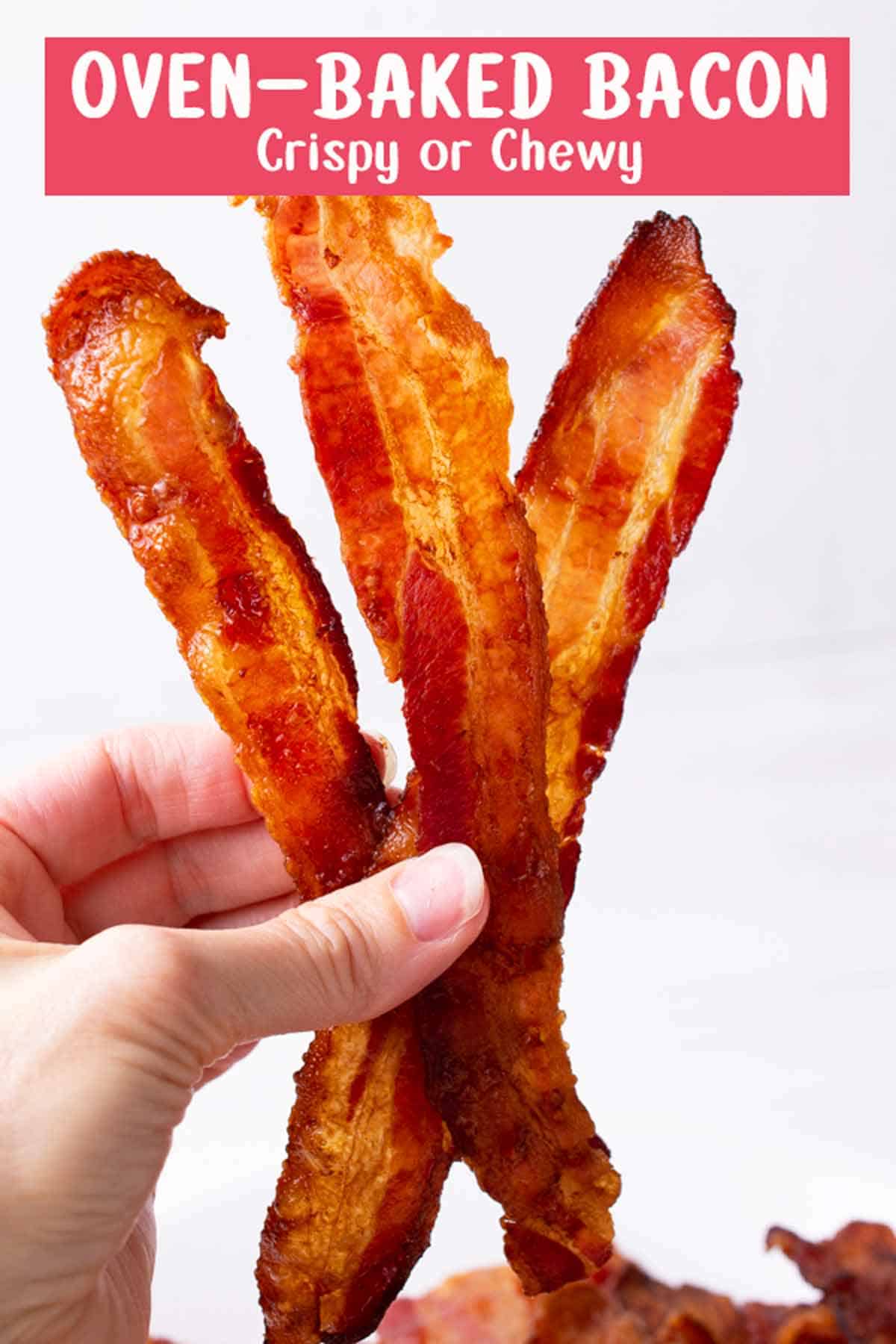
I baked lots of bacon in the oven to discover the best way to cook it.
I tested both Hormel and Oscar Mayer brands for this experiment. Both are readily available nationwide. I used regular bacon with thinner pieces and thick-cut bacon. With each cut, I tested all variables.
Variables Tested
- Cooking Temperatures: 350°, 375°, 400°, and broiling at 400°F (175°, 190°, and 200°C)
- Bacon Temperature: Straight from fridge vs. tempering bacon (bringing to room temperature first)
- Turning: Flipping bacon over halfway through cooking time vs. leaving it on the same side for the whole time
- Wire Rack or Pan: Cooking bacon directly on the pan vs. cooking it on a wire rack on top of the baking sheet.
- Covered or Uncovered: Cooking bacon uncovered vs. covering with aluminum foil, parchment paper, or another wire rack
- Pan Lining: Lining the pan with aluminum foil vs. parchment paper vs. no lining
- Cold or Preheated Oven: Putting bacon in the cold oven vs. adding bacon to a preheated oven
I tried to experiment with as many variables as possible to get the big picture.
Equipment You Need
- Raw bacon – your favorite kind of bacon (any brand, any thickness)
- Large baking sheet pan rimmed with sides to catch the bacon grease
- Aluminum foil or parchment paper to line the baking sheet pan (optional)
- Wire rack that fits inside the baking sheet pan (optional)
- Tongs to flip the bacon during cooking (optional)
Helpful Tips:
- Use a rimmed baking sheet (with sides) whether you line the pan or use a wire rack in the baking sheet. Bacon grease will spill into the oven if the pan does not have sides.
- Line the pan with aluminum foil (best) or parchment paper for easier cleanup. Parchment paper cannot fully contain the grease. There will be extra cleanup if you use parchment paper.
- Cooking bacon straight on the baking sheet will make an enormous mess.
- Know your oven. If it has hot spots, rotate the baking sheet during cooking. For more information on your oven hot and cold spots, see the post on how to fine tune your oven temperature.
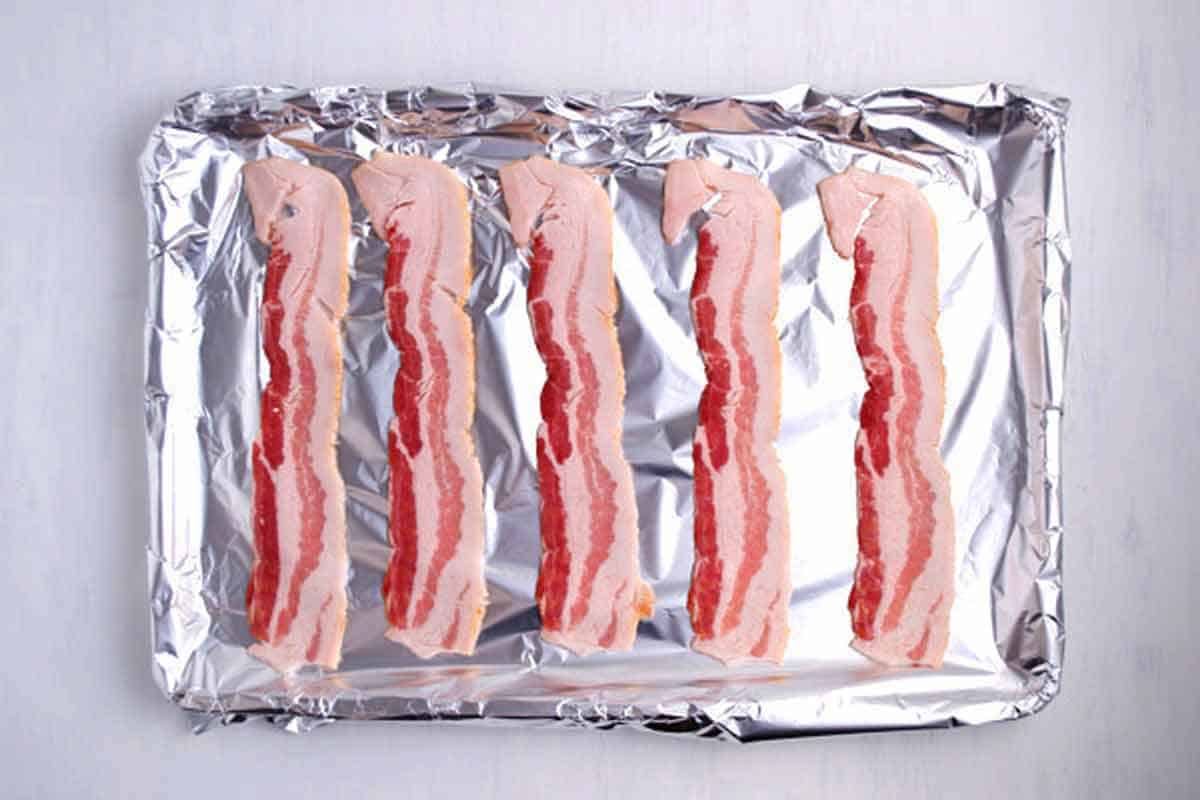
To use foil, fold the aluminum foil over the sides of the pan to keep the bacon grease from leaking onto the baking sheet.
During cleanup, fold the foil inward to trap the oil, keeping the baking sheet grease-free.
Summary of Results
The experiments revealed that only two techniques affect the final result of oven-cooked bacon. Cooking directly on the pan vs. on a wire rack AND flipping vs. no flipping bacon strips halfway through the cooking time.
Should You Cook Directly on a Rimmed Pan or on a Wire Rack?
Do you want perfect crispy bacon or bacon with a little chew? Where you cook the bacon will determine the level of crispiness.
| Cook Bacon on Wire Rack | Cook Bacon Directly on Pan |
|---|---|
| Chewy bacon | Crispy bacon |
| Increased cook time 3-7 minutes | Decreased cook time by 3-7 minutes |
| Minimal shrinkage | Noticeable shrinkage |
| Cooked straight | Curled during cooking |
Cooking bacon on a wire rack versus cooking it right on a rimmed cookie sheet (whether lined or not):
- Decided whether the bacon was chewy or crispy
- Affected cook time (all other variables the same)
- Changed the shrinkage of the bacon when it cooked
- Influenced whether bacon remained straight or curled
Wire Rack

Do you like bacon with a bit of chew? An oven-safe cooling rack set on top of the baking sheet is the technique for you.
- Produced chewy bacon
- Took 3 to 7 minutes longer to cook (depending on the oven temperature and the thickness of the bacon)
- Minimal shrinkage
- Remained straighter
Rimmed Baking Sheet
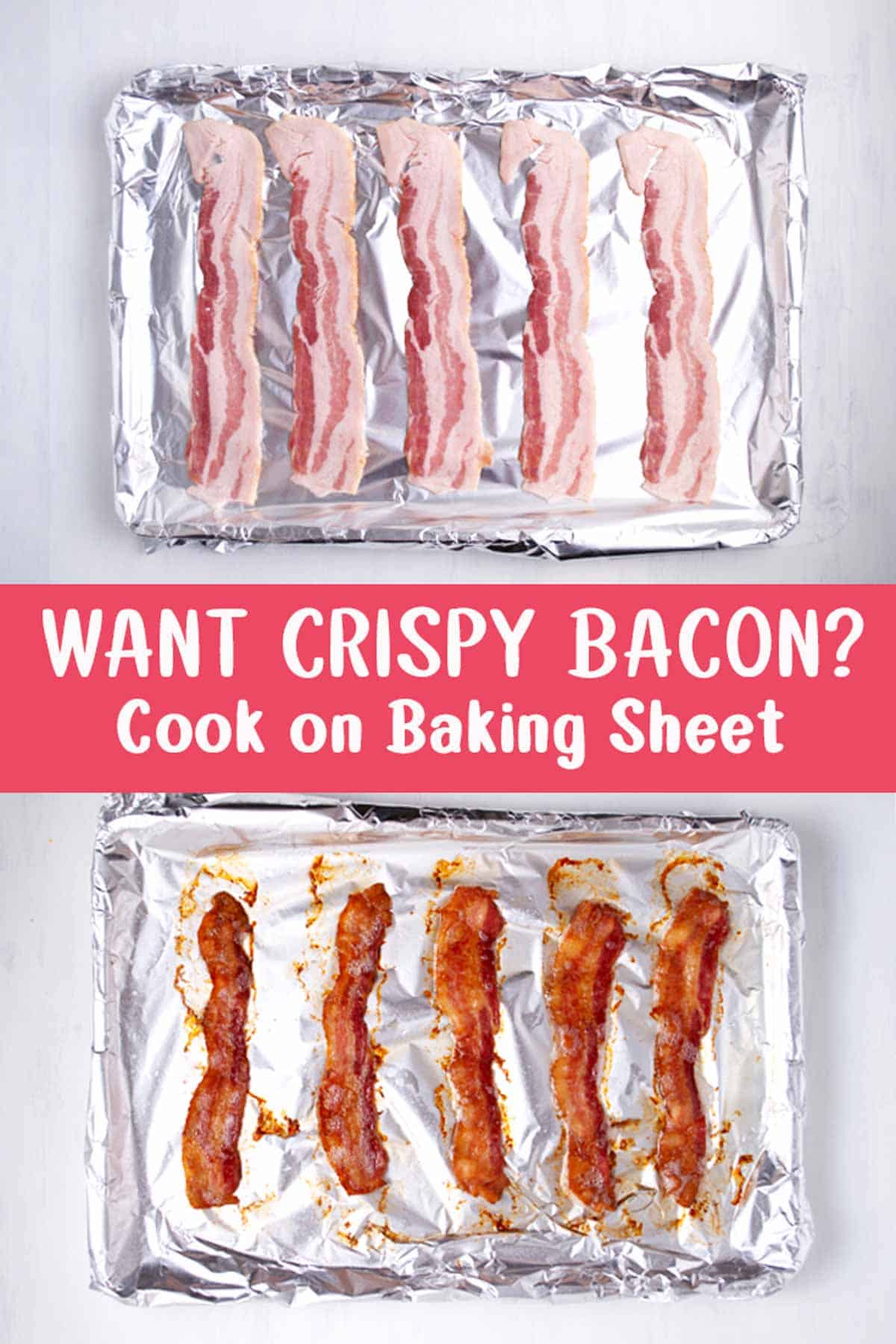
Looking for perfect crispy bacon? Cooking bacon in its own grease on a baking sheet is your answer. It is an easy method to produce crisp and perfect bacon every single time.
- Delivered crispy bacon
- Cooked 3 to 7 minutes faster
- Bacon shrank noticeably
- Slices curled more
Flip or No Flip
Do you care if your bacon is straight or crooked? Flipping it while it cooks is a simple trick to keep bacon straight.
Turning bacon halfway through baking time:
- Decided whether bacon stayed straight or ended up crooked
- Influenced whether bacon (cooked on a cooling rack) stuck to the rack after it finished cooking
| Bacon Flipped During Cooking | No Flipping During Cooking |
|---|---|
| Cooked straighter | Cooked crookedly |
| Shrank during cooking | Minimal shrinking |
| Did not stick to wire rack | Stuck to wire rack |
If you plan to flip your bacon, do it just over halfway through the baking time. Here are some of the results of flipping bacon.
- Flipped bacon cooked straighter than unflipped bacon, but it shrank a bit more.
- Flipped bacon cooked on a cooling rack did not stick to the rack. However, unflipped bacon stuck to the cooling rack. The longer it was left to cool, the more it stuck. Often it would fall apart when I tried to remove it.
Thin bacon is tough to manage when it sticks to the rack.
If you don’t turn the bacon and want to avoid it sticking to the pan:
- Take the bacon off the rack immediately after removing the pan from the oven.
- Or spray the rack before you cook the bacon. Not ideal since there is already a lot of fat and grease in bacon.
Other Important Variables to Understand
Temperature
Varying the temperature did not change the characteristics of the cooked bacon. The only impact of changing the oven temperature was changing the exact baking time of the bacon.
Cooking bacon on the rack took 3 to 7 minutes longer than cooking it directly on the pan.
- Baking at 375°F (190°C) (my favorite temperature) takes 20-25 minutes.
- Broiling was my least favorite. I really had to keep an eye on it to make sure it didn’t burn.
And you must flip the bacon strips halfway through the baking time to evenly cook them. This isn’t optional, so broiling isn’t going to work for you if you are after a hands-free method.
Recommended Baking Times Based on Oven Temperature
As always, use your senses — sight and smell to figure out when your bacon has cooked the way you like it.
Here are some general baking time guidelines for cooking bacon in the oven. Remember, the thickness of your bacon factors into the cooking time. Thin bacon cooks in less time than thick bacon.
| Cooking Temperature | Bacon Placement | Cooking Time |
|---|---|---|
| 350°F (175°C) | on a wire rack in pan | 22-25 minutes |
| 350°F (175°C) | directly on pan | 20-24 minutes |
| 375°F (190°C) | on a wire rack in pan | 20-23 minutes |
| 375°F (190°C) | directly on pan | 15-20 minutes |
| 400°F (200°C) | on a wire rack in pan | 17-23 minutes |
| 400°F (200°C) | directly on pan | 12-17 minutes |
| Broil @ 400°F (200°C) | directly on pan | 5-7 minutes (flip after 3-4 minutes) |
How to Temper Bacon
To temper bacon, bring it to room temperature before cooking. Tempering often helps meat (especially thicker meat) cook more evenly.
Bacon is thin, so cooking it evenly is not usually a problem. The result of tempering the raw bacon?
Tempered bacon cooked a minute or two faster than bacon pulled straight from the refrigerator.
I recommend pulling the bacon from the refrigerator and then turning on the oven. When the oven heats and the bacon is on the pan, it should be tempered enough.
Baking Sheet With Crumpled Foil
If you don’t have a wire rack, but would like chewy bacon, consider crumpling foil on a baking sheet. Lay the raw bacon across the foil in a single layer.
This cooks the bacon out of the grease, but it is a pain. The bacon will stick to the foil and be challenging to flip.
How to Cook Bacon in the Oven
Cooking bacon in the oven truly is a “choose your own adventure.” You can decide if you want it crispy or chewy and straight or not.
If you want crispy bacon, cook it on the baking sheet in its own grease. Want it to be perfectly straight? Then flip it halfway through the baking cycle.
Is chewy bacon for you? Then cook it on a rack on the baking sheet, separating it from its grease. The strips will stay long and thin. It won’t stick as easily to the pan if you flip it halfway through the cooking time.
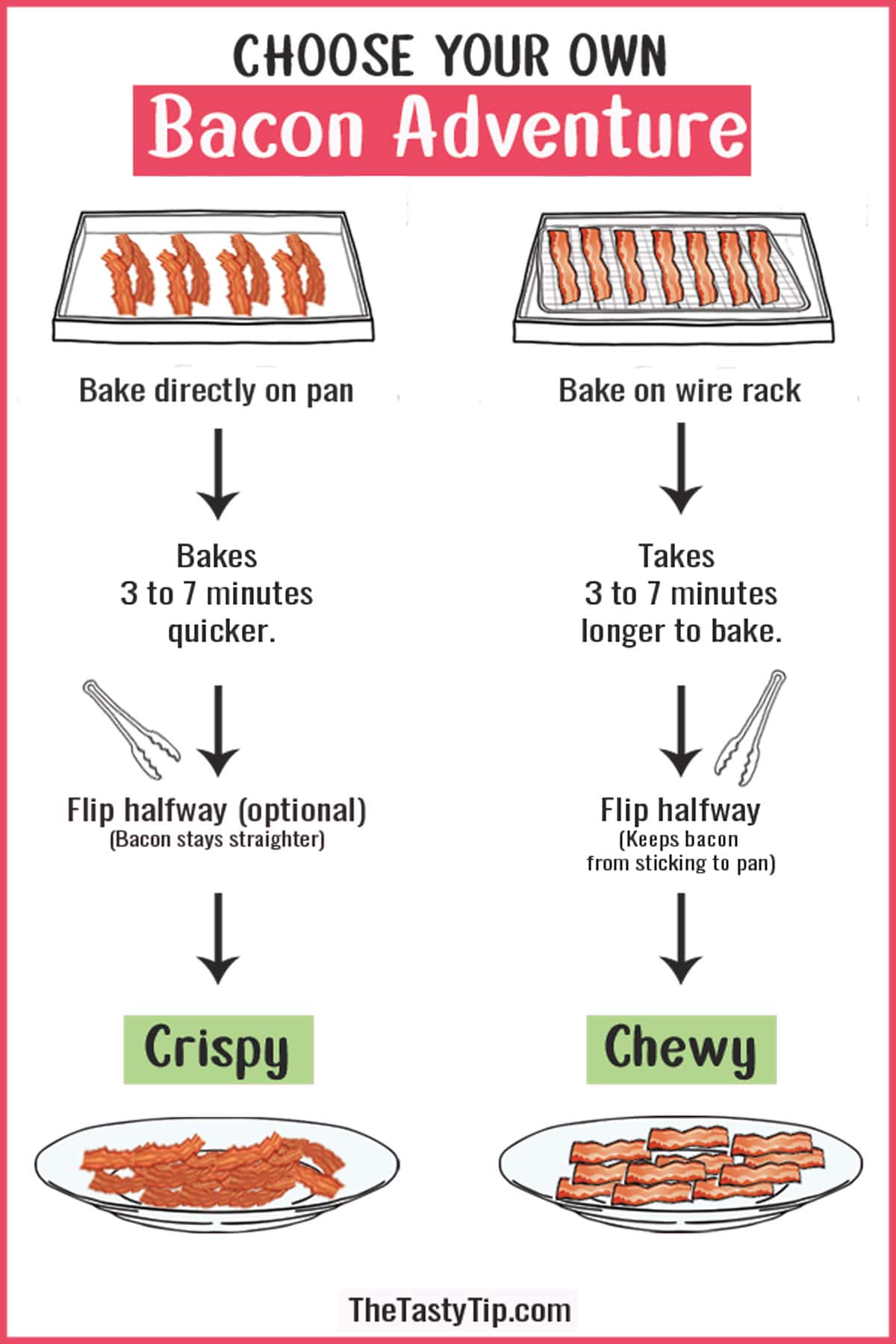
Directions:
- Pull the bacon out of the oven. Turn the oven on to 375° F (190° C).
- Choose a rimmed baking sheet. Then line it with aluminum foil. Place a wire rack on top of the baking sheet (for chewy bacon).
- Place the raw bacon strips in a single layer in the pan or on the wire rack. It’s OK if the strips of bacon touch because they will shrink. However, they should not overlap, or they will cook unevenly.
- When the oven reaches the right temperature, put the pan of bacon into the oven.
- Cook for 15 to 20 minutes if the bacon is in the pan or 20 to 25 minutes if the bacon is on the wire rack.
- If you want the bacon to stay straight (and easily come off the wire rack), flip it halfway through the baking time.
- When the bacon is done, remove it from the oven and place it on a plate lined with paper towels to drain.
- Serve it while it is still hot.
How to Store Leftover Bacon
If you have leftover bacon, cool it first. Then store it in an airtight container in the refrigerator. It will last 4 or 5 days.
To reheat, warm each slice in the microwave for 10 to 15 seconds.
What is the best temperature to cook bacon in the oven?
Listed below are typical oven temperatures for cooking bacon, along with the projected cook time for each temperature.
- 350°F (175°C) on a rack for 22 to 25 minutes
- 350°F (175°C) directly on the pan for 20 to 24
- 375°F (190°C) on a rack for 20 to 23 minutes
- 375°F (190°C) directly on the pan for 15 to 20 minutes
- 400°F (200°C) on a rack for 17 to 23 minutes
- 400°F (200°C) directly on the pan for 12 to 17 minutes
Frequently Asked Questions
To cook crispy bacon, lay the bacon straight on a rimmed baking sheet pan. Line the pan with aluminum foil for easy cleanup. Try not to let the bacon pieces touch. As it cooks in its own grease, it will get crispy.
The best way to cook bacon in the oven with less mess is to line the pan with aluminum foil.
Make sure the foil rises over the pan edges. Fold the foil down to prevent grease from spilling into the oven.
When the bacon has finished cooking, remove the pan from the oven. Transfer the bacon to a plate lined with paper towels to drain.
When the grease and the pan have cooled, carefully pour the oil into a heat-safe container.
Remove the foil from the pan and throw it out. Your pan should not be greasy at all if you have used enough foil to reach over the sides of the pan and have removed the foil carefully.
You don’t need foil to cook bacon in the oven. However, your pan will collect all the grease, making it more time-consuming to clean.
You can cook bacon on parchment paper. However, parchment paper does not fold and stay in place like aluminum foil. This means the paper cannot keep the bacon fat enclosed like aluminum foil can. As a result, it will take longer to clean your pan.
To cook bacon in the oven without a rack, place the bacon directly on a rimmed pan lined with aluminum foil.
Use thick-cut bacon for best results. Lay the bacon strips in the pan or on the rack. Sprinkle with brown sugar. Cook for 20 to 25 minutes. Optional: Flip the strips halfway through the baking time.
After the bacon has finished cooking, lay it on a plated lined with paper towels and quickly dab away the hot grease. Transfer to a clean plate without paper towels to cool.
The brown sugar will stick to the paper towels if the bacon is left on it too long.

After cooking your bacon in the oven, don’t forget to catch and store your leftover bacon grease. Use the fat to fry eggs, sauté veggies, and flavor baked beans.
Did you like this post? Then let's be social. FOLLOW ME on INSTAGRAM and PINTEREST to keep up with the latest happenings.
Recipe
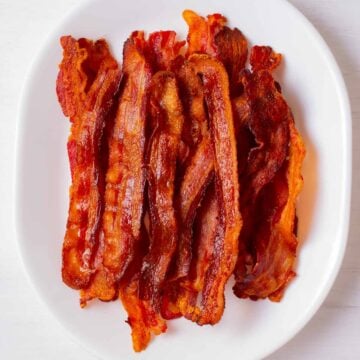
Oven-Cooked Bacon
Ingredients
- 1 pound of bacon good quality, favorite cut
Instructions
CRISPY BACON DIRECTIONS
- PULL the bacon out of the refrigerator.
- PREHEAT the oven to 375°F (190°C). Place the oven rack in the center of the oven.
- LINE a rimmed baking sheet with aluminum foil. Fold the foil up over the sides so the bacon grease does not leak onto the pan.
- LAY the bacon strips onto the foil without overlapping. Touching is fine because the bacon will shrink.
- PLACE the baking sheet in the oven in the center of the oven rack.
- BAKE for 15 to 25 minutes, based on thickness of bacon and your taste. Rely on your senses of sight and smell to determine when the bacon is done the way you like it. OPTIONAL: Flip the bacon at 10 minutes and continue cooking until done.
- DRAIN the cooked bacon on a plate lined with paper towels.
CHEWY BACON DIRECTIONS
- PULL the bacon out of the refrigerator.
- PREHEAT the oven to 375°F (190°C). Place the oven rack in the center of the oven.
- LINE a rimmed baking sheet with aluminum foil. Fold the foil up over the sides so the bacon grease does not leak onto the pan.
- PLACE an oven-safe metal baking rack in the baking sheet pan.
- LAY the bacon strips on the wire rack without overlapping. Touching is fine because the bacon will shrink.
- PLACE the baking sheet in the oven in the center of the oven rack.
- BAKE for 10 minutes.
- USE TONGS to flip the bacon strips over.
- CONTINUE BAKING for 8 to 12 minutes, based on thickness of bacon and your taste. Rely on your senses of sight and smell to determine when the bacon is done the way you like it.
- DRAIN the cooked bacon on a plate lined with paper towels.
Notes
Nutrition
Did you make this recipe? Tag @thetastytip on Instagram and hashtag it #thetastytip.
Best Recipes with Bacon
You probably don’t need any help with finishing off your bacon. But here are a few delicious recipes with bacon.
- Cobb salad: The ultimate Cobb salad recipe with chicken makes a full meal with greens, bacon, vegetables, and a fresh vinaigrette.
- Topping for split pea soup with ham or with a hambone.
- Refried beans. Smart tips to make canned refried beans taste like restaurant style. It all starts with toasting some spices in leftover bacon grease.
Do you like crispy or chewy? Comment below and let me know how you baked your bacon.

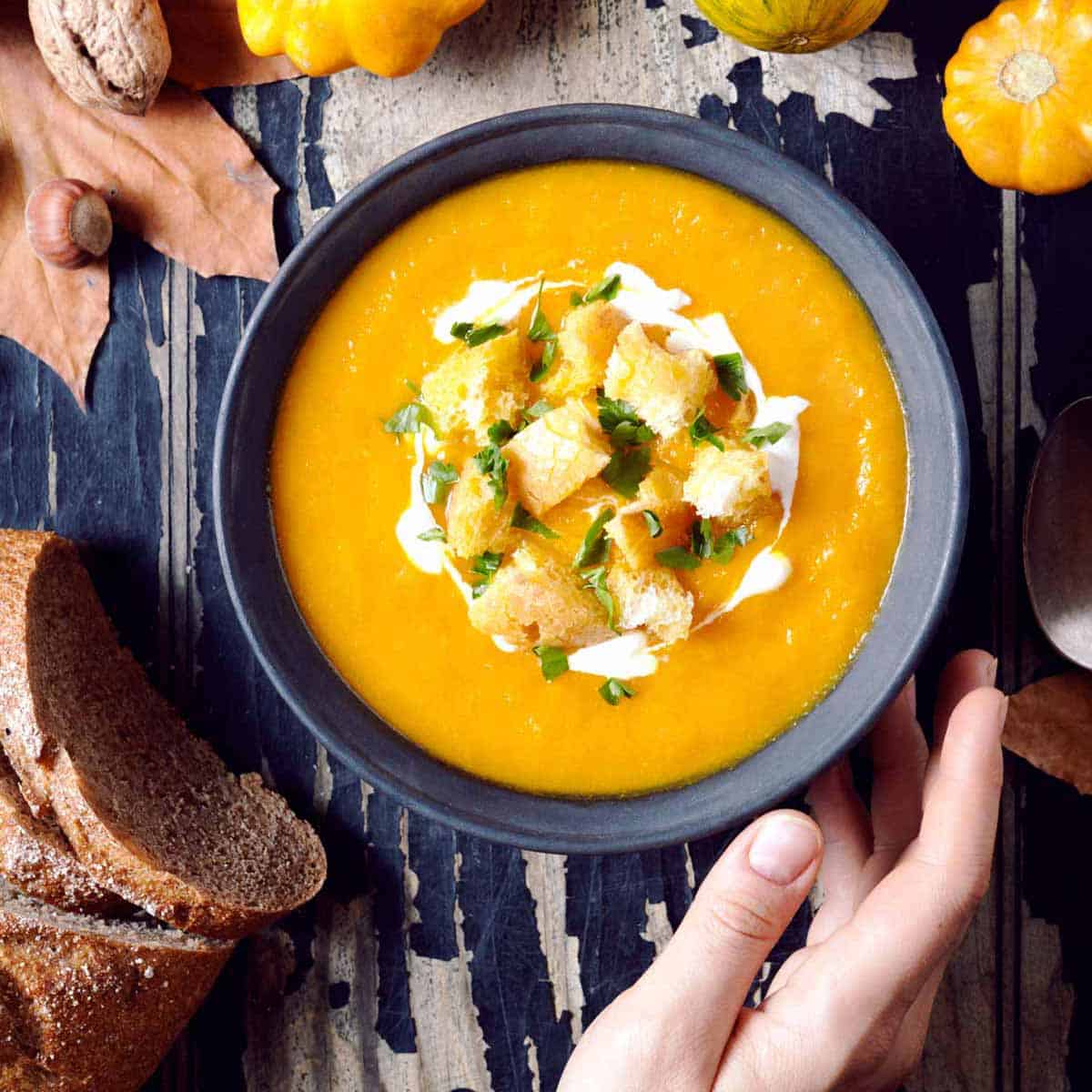
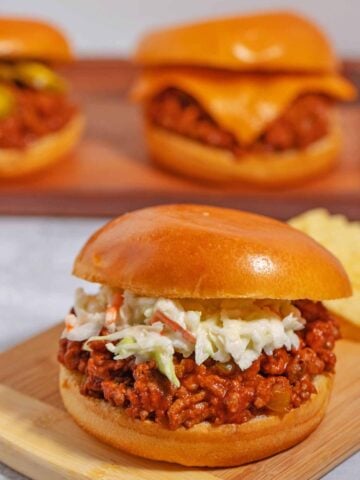
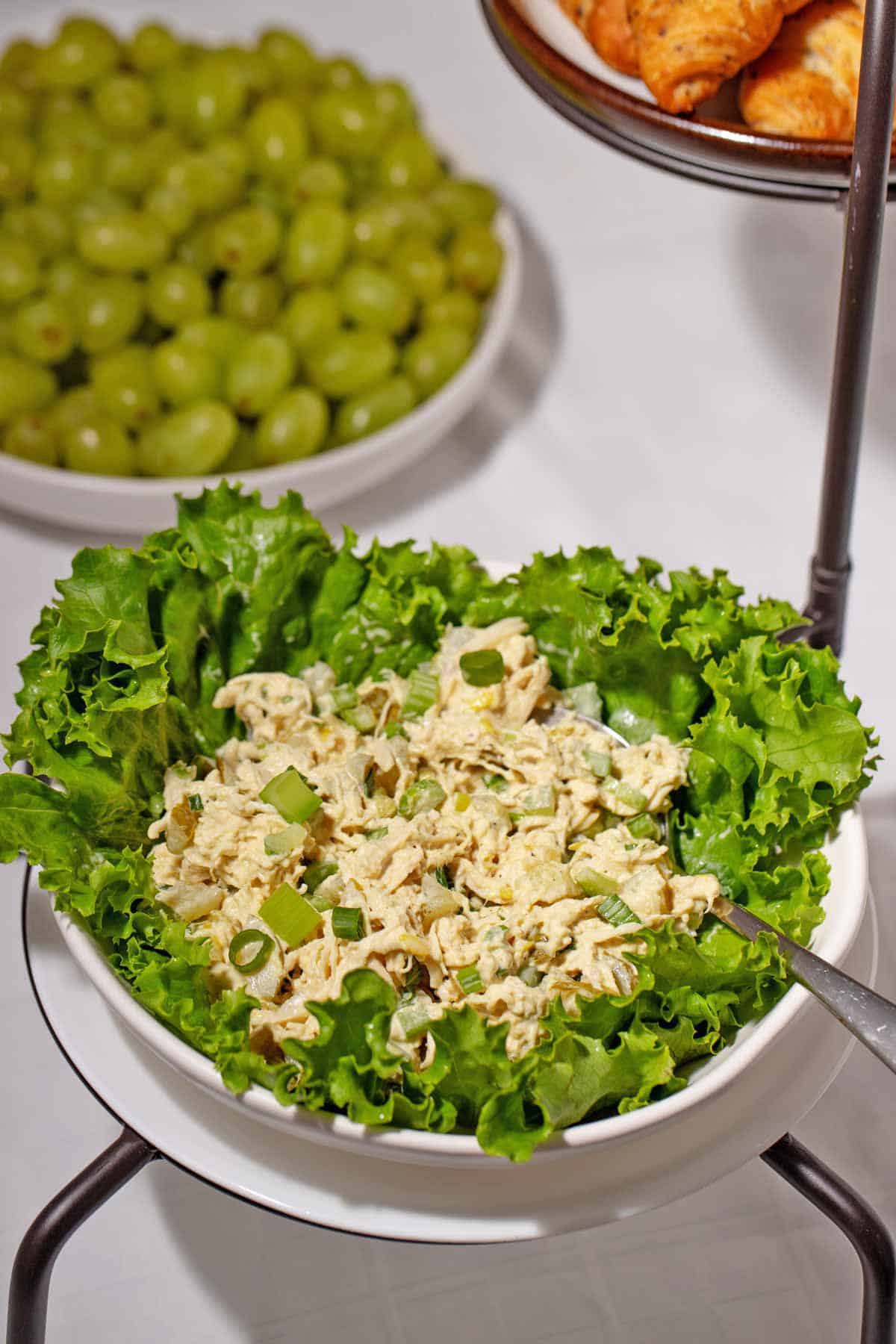
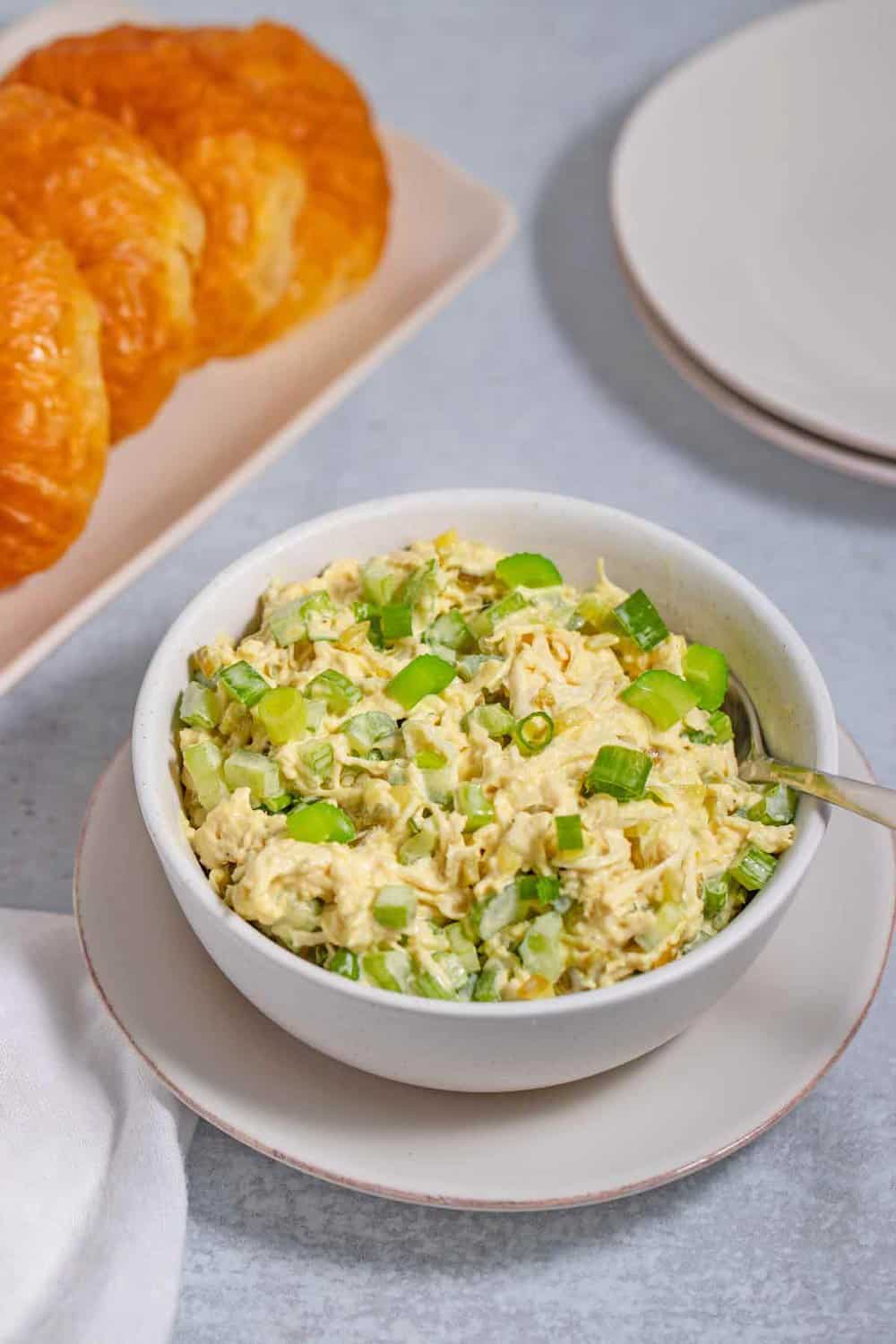
Souq4us
For maple baked bacon, bake for 12-15 minutes and remove from the oven. Brush maple syrup onto the bacon slices then place back into the oven for another 3-5 minutes until golden brown and crispy. For honey sriracha bacon, bake for 12-15 minutes and remove from the oven. Brush honey and sriracha onto the bacon slices then place back into the oven for another 3-5 minutes until golden brown and crispy.
Tami Mack @ The Tasty Tip
Sounds tasty. I'll have to give it a try.